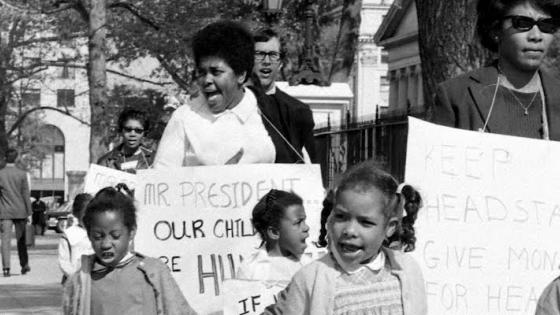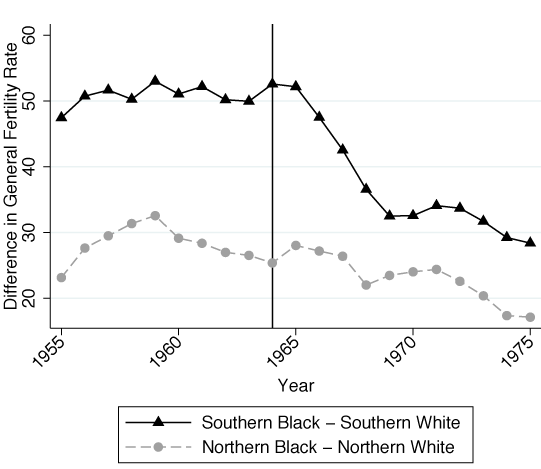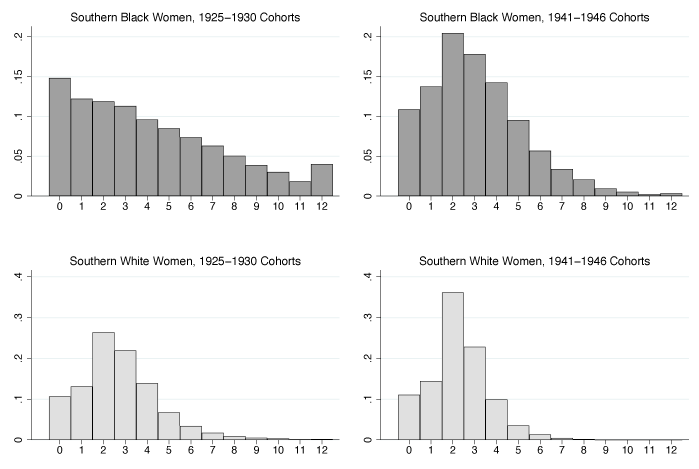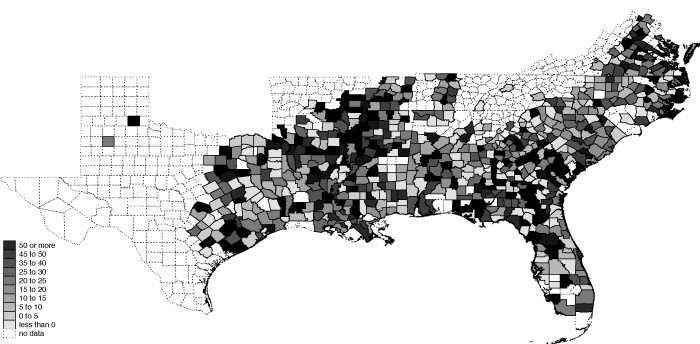Throughout the world, a central aspect of inequality is the disparity in economic outcomes across racial and ethnic groups. In the US, these disparities are typically most pronounced between African Americans and Americans of European descent. Policymakers and academic researchers share a commitment to understanding and reducing black–white disparities in earnings, educational attainment, test scores, health, and other measures of socioeconomic wellbeing.
Within the context of discussions on racial inequality, a large and persistent difference in the fertility levels of African Americans and whites remains a highly relevant feature of US demography. The ‘completed’ childbearing and fertility rates of black women have exceeded those of white women for as long as fertility statistics have been collected (Tamura et al. 2016, Bailey and Hershbein 2018).
These fertility differences are, in part, an effect of discrimination and general racial inequality: discrimination in labour markets and unequal access to educational and medical services reduces the opportunity-cost of children and constrains the ability of African American parents to invest heavily in the human capital of a smaller number of children, incentivising higher fertility levels. At the same time, racial fertility differentials are one likely cause of the persistence of racial inequality: research shows that fertility events have large and sustained negative impacts on women’s earnings (Kleven et al. 2019) and that larger family sizes have negative effects on children’s educational and labour market outcomes (Black et al. 2005, Sacerdote 2007). Racial fertility differentials mechanically lower the earnings of black households and cause the average African American child to come from a larger family.
The impact of the 1964 Civil Rights Act on racial fertility gaps in the US
Given these strong and multidirectional relationships between fertility and socioeconomic outcomes, understanding the nature and causes of racial inequality generally requires understanding the nature and causes of fertility disparities, specifically. Recent research has attempted to better understand the nature and origins of racial fertility differentials using historical events, from implementation of the Fugitive Slave Act, which reduced the likelihood of successful escape from enslavement (Allen 2015), to the building of Rosenwald Schools, a philanthropic effort to increase access to education among African Americans in the Jim Crow South (Aaronson et al. 2014).
Another key event in the history of racial fertility gaps is the 1964 Civil Rights Act. The legislative culmination of the decades-long civil rights movement, the Civil Rights Act precipitated a period of rapid progress among African Americans across a wide variety of economic, social, and political dimensions, with gains strongly concentrated in the South (Wright 2013). In studying the fertility impacts of the Civil Rights Act, I found a striking reduction in the relative fertility of southern African Americans immediately after 1964 (Thompson 2019).
The basic trends are shown in Figure 1, which uses Vital Statistics data to plot the black-white gap in the general fertility rate (defined as the ratio of live births to women ages 14 to 44) over time, and shows that in 1964 there were 53 more live births per thousand women of childbearing age among southern blacks than there were among southern whites. By 1969 the gap had fallen to 33 births, a decline of approximately 40% over a five-year period. In strong contrast, Figure 1 shows that black-white fertility-rate differences outside the South were effectively unchanged over the same period.
Figure 1 Black−white differences in the general fertility rate
The fertility rates shown in Figure 1 are distinct from the total number of children born over the course of a woman’s childbearing years, or her completed fertility. To investigate which parity margins drove the reported fertility rate trends, Figure 2 shows how the completed fertility of southern African American women changed over time, relative to southern whites. The top panels of Figure 2 show a dramatic truncation of the right-tail of the completed fertility distribution among southern black women who were born between 1925-1930 (and whose prime child-bearing years were therefore prior to 1964) versus those who were born between 1941-1946 (with prime child-bearing years therefore coming after 1964). In particular, Figure 2 shows that large numbers of southern black women substituted out of completed fertility levels in the range of 6-12 children ever born, and into fertility levels in the range of 1-4 children ever born. The bottom panels of Figure 2 show no comparable changes in the completed fertility of southern white women during this period.
Figure 2 Changes in completed fertility distributions
Drivers of the shifts in fertility behaviour
Why did the dramatic shifts in fertility behaviour shown in Figures 1 and 2 occur?
One set of possible explanations relate to relative improvements in the socioeconomic status of southern African American women. Large empirical and theoretical literatures find strong relationships between fertility and factors such as real and potential earnings, female educational attainment, and the prevalence of agricultural employment (Becker 1960, Galor 2012), all of which improved differentially for southern blacks after 1964 (Wright 2013). Still, decompositions using data from the 1960 and 1970 Decennial Censuses indicate that while these factors contributed significantly to convergence – explaining approximately 30% of the observed fertility declines – socioeconomic status alone is not a complete explanation.
Although relative improvements in economic opportunity were an important feature of the civil rights-era South, changes in the circumstances of southern African Americans after 1964 extended well beyond the labour market. For instance, the desegregation of southern schools and hospitals directly reduced barriers to investing in children’s human capital development and increased the efficacy of such investments. Mechanisms of a more sociological and psychological nature are plausible as well: the desegregation of buses and lunch counters had only modest direct economic consequences but carried great social significance, and may have had a meaningful impact on expectations about future levels of opportunity, thereby influencing southern African Americans to modify their fertility choices.
Finally, in addition to the 1964 Civil Rights Act, this period witnessed the passage and implementation of many other potentially relevant policies, including the 1965 Voting Rights Act, the roll-out of numerous War on Poverty and Great Society programs, the introduction of oral contraception and the national legalisation of abortion, the Vietnam War draft, and expansions in the coverage of the federal minimum wage.
One way to parse these potential mechanisms is to observe which areas of the South experienced the strongest convergence. Figure 3 maps the changes in the black-white fertility gap between 1964 and 1969 by county, and shows that the strongest convergence occurred in counties along the Mississippi River Delta, selected counties in central Alabama and Georgia, and counties in the tobacco-growing regions of Virginia and North Carolina.
Figure 3 County-level convergence in black-white general fertility rate differential
Notes: Figure displays the change in the difference between the general fertility rates of non-whites and whites that occurred in each county between 1964 and 1969. Counties where African Americans constituted less than 99% of non-whites are excluded.
Estimating correlations between the local strength of convergence shown in Figure 3 and various county characteristics, I find a positive association between black fertility declines and the intensity of local school desegregation, hospital access, and War on Poverty programmes. But perhaps most interestingly, a county’s historical intensity of slavery and lynching activity are the strongest spatial correlates of fertility convergence by a substantial margin. I interpret these correlations as suggestive evidence that the social and psychological ramifications of dismantling the most overt forms of state-sponsored racism contributed to black-white fertility convergence in the civil rights era.
Policy implications
Taken as a whole, these findings have at least two important sets of implications.
First, they indicate that fertility choice was extraordinarily responsive to changes in discriminatory institutions in the Civil Rights context. This mirrors the findings of prior research in other historical contexts, and strongly suggests that institutionalised and state-sponsored discrimination have been an important contributor to racial fertility differences. The extent to which this holds true for marginalized groups in other contexts – for Roma populations in European countries or historically marginalised castes in South Asia - presents an interesting direction for future work.
Second, the findings offer a novel potential explanation for why African American children from the cohorts of the 1960s and early 1970s exhibited rapid improvements in test scores, educational attainment, and adult labour market outcomes, which have been the focus of a large, active literature (Neal 2006, Magnuson and Waldfogel 2008, Chay et al. 2009 and 2014, Fryer 2011). In particular, the demonstrated fertility patterns imply possibly dramatic changes in ‘who was born’ during the civil rights era, and even in the absence of positively selected fertility, the documented trends will have mechanically reduced family size for the average southern black child from these cohorts. Quantifying how fertility convergence contributed to subsequent racial disparities in a broader set of outcomes is another promising direction for future research.
References
Allen, T (2015), “The promise of freedom: Fertility decisions and the escape from slavery”, Review of Economics and Statistics 97(2): 472-484.
Aaronson, D, F Lange and B Mazumder (2014), “Fertility transitions along the extensive and intensive margins”, American Economic Review 104(11): 3701-3724.
Bailey, M and B Hershbein (2018), “US fertility rates and childbearing, 1800-2010”, Oxford Handbook of American Economic History.
Becker, G (1960), “An economic analysis of fertility”, in Demographic and economic change in developed countries, Columbia University Press: 209-240.
Black, S, P Devereux and K Salvanes (2005), “The more the merrier? The effect of family size and birth order on children's education”, Quarterly Journal of Economics 120(2): 669-700.
Chay, K, J Guryan and B Mazumder (2009), “Birth cohort and the black-white achievement gap: The roles of access and health soon after birth”, NBER Working Paper.
Chay, K, J Guryan, and B Mazumder (2014), “Early Life Environment and Racial Inequality in Education and Earnings in the United States”, NBER Working Paper.
Galor, O (2012), “The demographic transition: causes and consequences”, Cliometrica 6(1): 1-28.
Kleven, H, C Landais, J Posch, A Steinhauer and J Zweimüller (2019), “Child penalties across countries: Evidence and explanations” NBER Working Paper.
Magnuson, K and J Waldfogel (2008), Steady gains and stalled progress: Inequality and the Black-White test score gap, Russell Sage Foundation.
Neal, D (2006), “Why has black–white skill convergence stopped?”, Handbook of the Economics of Education 1: 511-576.
Sacerdote, B (2007), “How large are the effects from changes in family environment? A study of Korean American adoptees”, Quarterly Journal of Economics 122(1): 119-157.
Tamura, R, C Simo and K Murphy (2016), “Black and white fertility, differential baby booms: The value of equal education opportunity”, Journal of Demographic Economics 82(1): 27-109.
Thompson, O (2019), “Fertility Decline in the Civil Rights Era”, NBER Working Paper.
Wright, G (2013), Sharing the prize, Harvard University Press.






